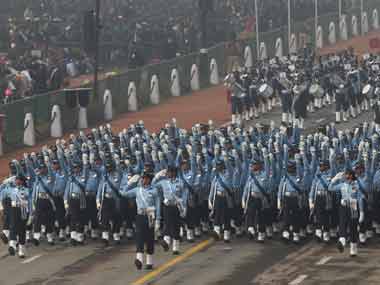It is that time of the year again. As India celebrates the 70th Republic Day on 26 January, the debate rages over the need for the parade and the so-called muscular message of militarism it conveys. Parallels are often drawn with the Independence Day celebrations — where the armed forces are present but the thrust of the event is political — to demand “demilitarisation” of the Republic Day parade which to some symbolises jingoism. The parade marks India’s arrival as a republic which happened a couple of years after it gained independence on 15 August, 1947. There is a connection between the two occasions but the significance of becoming a republic and respecting the primary symbols associated with it are of great importance. [caption id=“attachment_2598940” align=“alignleft” width=“380”] Representational image. AP[/caption] Months after independence, India was dragged into its first armed conflict over Kashmir. Even as it grappled with the world’s biggest refugee crisis resulting from the Partition, key institutions of the state responded with alacrity to first contain and then pushback the Pakistani move to wrest Kashmir. All this was happening while India debated the shape, structure, and ethos of its Constitution — the most important requirement of an independent nation and a republic. The last shackles of imperial institutions are finally jettisoned once a republic is constituted and the law book becomes supreme rather than an individual. It is another matter that some institutions of the state have become more imperial than their predecessors but that debate is for another day. The form and message of the parade continue to be a matter of discussion, which has only got more animated over the time. The naysayers have been around from the day India was declared a republic, always coming up with some bizarre reason or the other. For them, anything military is anathema and anything patriotic is avoidable at all costs. They believe such symbols are at the root of militarising a society, which in their estimation is akin to fascism. Children get brainwashed, are led astray and tend to support extremist positions under the influence of these smart uniforms and shiny brass. All that heavy weaponry on display at Rajpath encourages an insidious gun culture. Such is the thinking of the naysayers and these are their constantly expressed thoughts. Their line of argument is as predictable as they are incorrect. Predictable because these points are fairly universal, and used around the world to express opposition to all such parades and military functions. Peaceniks all over the world use the same language to explain their opposition to militaries, in general, and parades, in particular. These are also incorrect because there is no proven co-relation between military parades, brainwashed children, armed violence and creeping fascism. In fact, the reverse could well be true of India. Among all the democracies and republics, India is easily the least militarised society in the world. It has the lowest percentage of the population in uniform, armed or otherwise. India’s supposedly large armed forces, in fact, pale in comparison to most countries when it comes to the proportion of the population. Despite being deployed in operational responsibilities for more than 50 years, the armed forces, especially the army, remain outside our daily lives in terms of eulogising press coverage, etc. As far as society at large is concerned, the army is still isolated, which is a pity. Also Read - Republic Day Parade: Tanks and artillery are passe, 26 Jan celebrations require renewed focus on power of people There are countries that don’t shy away from showing respect to their military. To cite just one example, which is enviable and copyable, every Russian couple visits the nearest military mausoleum after exchanging marriage vows and only then do the celebrations begin. Those in service get married in uniform, making the occasion even more significant. Such is the respect that the military draws from the people who use each and every occasion to express their gratitude to the uniform that keeps them safe. This is so unlike India, where there is only one occasion for the people to turn out in numbers to cheer, respect, and show an indebtedness to their guardians. Majority of India is quite happy with the fact that someone else is wearing the uniform and going out there to do the dirty job of fighting. The Republic Day parade offers them a chance to thank their protectors. But, even that one occasion is constantly questioned by an ungrateful minority. Thankfully, most of India doesn’t read their pontifications and those who do, don’t really care. India respects its military, especially the army, and enjoys that one day when the might is on display. We should let them continue that swank and awe. The author is editor of Defence and Security Alert and was a member of the parliamentary standing committee on defence between 2004 and 2009 Follow LIVE coverage of Republic Day Celebrations here
Republic Day parade gives the people only opportunity to turn out in large numbers to cheer, respect, and show an indebtedness to the men and women in uniform
Advertisement
End of Article


)

)
)
)
)
)
)
)
)



